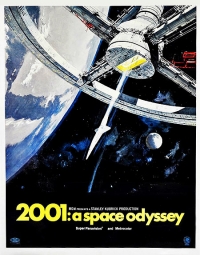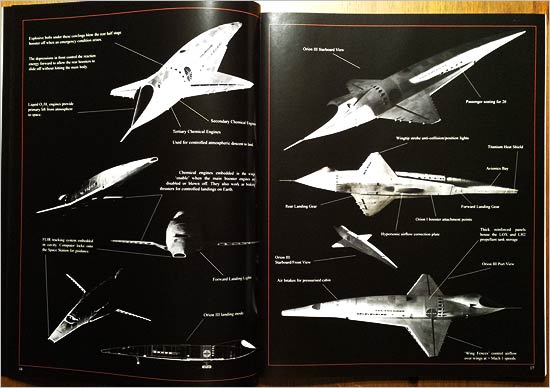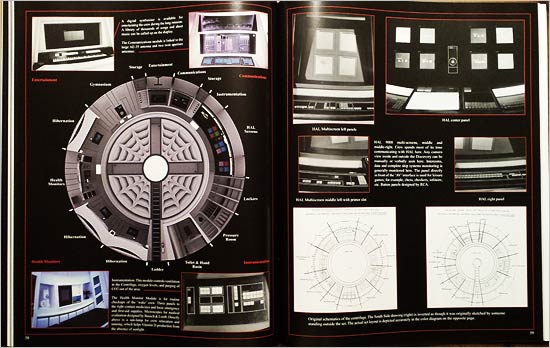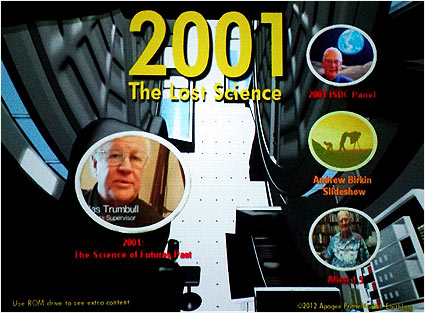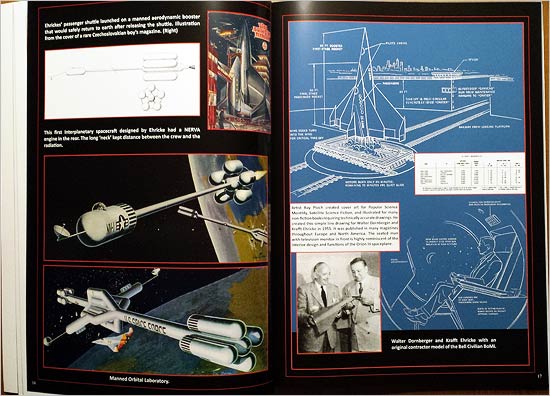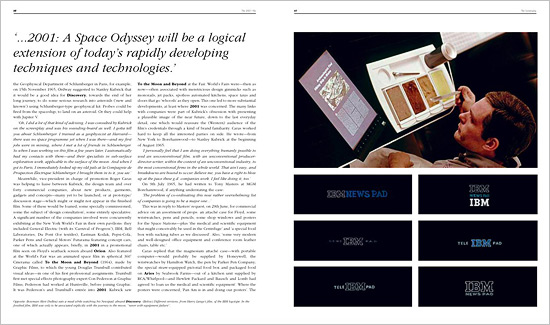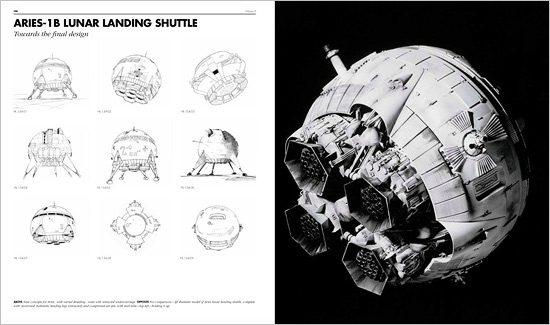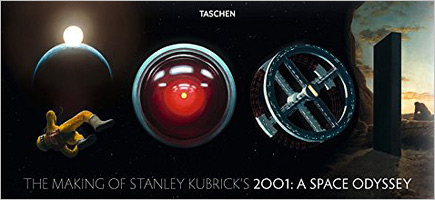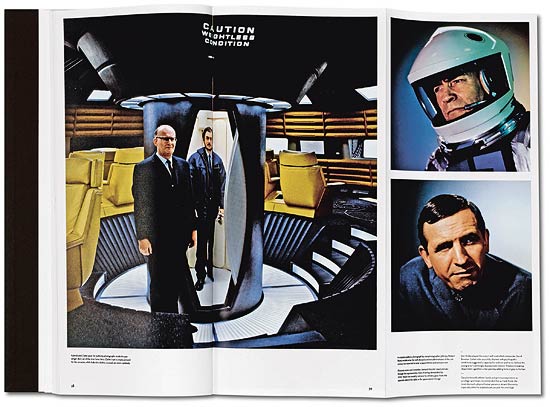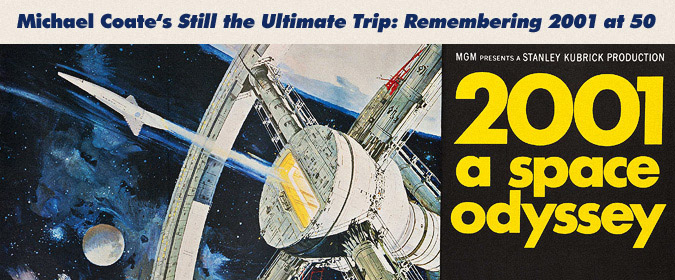For years, fans who wanted to learn more about the making of 2001 have had little to examine but the film itself. But recently a trio of publishers – including Apogee Books, Taschen, and Reel Art Press – have delivered terrific coffee table volumes that reveal and examine in high detail the effort involved in conceiving and designing the look of the film. These books also do a great service in celebrating two of the key artists who accomplished this task in the service of director Stanley Kubrick: Frederick I. Ordway III and Harry Lange.
Read on as I give each of these books its due…
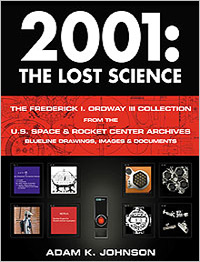 The first book that must be mentioned is Adam K. Johnson’s 2001: The Lost Science – The Frederick I. Ordway III Collection, which was published in 2012 by Apogee. The book is a paperback, but I think can justly be called a “coffee table” book because of its size: 12” x 14”. That may seem to make for awkward casual reading, but when you open the book up on a table, this large size quickly reveals itself as an advantage: Each page is capable of displaying both B&W and color production photographs, blueprints, or sketches in tremendous scale and detail – far greater than they would appear in a regular book.
The first book that must be mentioned is Adam K. Johnson’s 2001: The Lost Science – The Frederick I. Ordway III Collection, which was published in 2012 by Apogee. The book is a paperback, but I think can justly be called a “coffee table” book because of its size: 12” x 14”. That may seem to make for awkward casual reading, but when you open the book up on a table, this large size quickly reveals itself as an advantage: Each page is capable of displaying both B&W and color production photographs, blueprints, or sketches in tremendous scale and detail – far greater than they would appear in a regular book.
Ordway (who sadly passed away in 2014) was an accomplished aerospace engineer, who worked on rockets in the 1950s with Werner Von Braun, first at the Army Ballistic Missile Agency and later for NASA, where he continued through the Apollo era. During this time, he became friends with Arthur C. Clarke, who recommended him to Kubrick for 2001. In 1965, Kubrick hired Ordway and his friend and colleague at NASA, Harry Lange, to work on the film. Ordway took on the role of Lead Science Advisor and spent two and a half years creating sketches, plans, and designs for the film. That material was eventually collected and today resides in the archives of the U.S. Space & Rocket Center.
Apogee’s 2001: The Lost Science offers abundant background information on Ordway and the film, and then presents hundreds of these images – many never before seen – in large format and high quality over 112 pages. This material is a model builder’s dream, as the book is broken up into sections that include: Satellites, Orion III Spaceplane, Titov Spaceplane, Space Station V, Aries IB Shuttle, Clavius Base, Exploring the Moon, Tycho Magnetic Anomaly 1, and The Discovery. That final section is further divided into all the various aspects of the ship, including (but not limited to) the Pod Bay, the Command Module, EVA Pods, AE-35, and even HAL 9000. There’s also a section of great photos taken in the film’s Model Shop, as well as abundant Appendix material.
What’s more, the book includes a bonus DVD disc that offers the 2001: The Science of Futures Past documentary (39:01 – which features interviews with Arthur C. Clarke, Douglas Trumbull, Robert Sawyer, Adam Johnson, Robert Godwin, and others), a 2001 ISDC Celebrity Panel (75:58 – which is video of a panel discussion celebrating the film’s anniversary from the 2001 International Space Development Conference, moderated by Frederick I. Ordway III, and featuring “Moonwatcher” man-ape actor Dan Richter, aerospace artist and 2001 poster designer Robert McCall, and “David Bowman” actor Keir Dullea – the video is poor quality, but is well worth watching for its content), an Andrew Birkin Slideshow (8:14 – of various production documents from the collection of Andrew Birkin, who was a runner on the film), and Alien 1.5 (:24 – which is a funny moment of Arthur C. Clarke with his dog Pepsi). The disc also boasts DVD-ROM content, including 22 PDF documents that include vintage NASA reports, contractor studies, and technical documents relevant to 2001 (on such subjects as nuclear pulse propulsion, rotating space stations, and manned EVA pods).
 That book was followed up with a second volume from Apogee just this year: 2001: The Lost Science – The Scientists, Influences & Designs. It’s slightly smaller in size at about 11” x 14” and features just 88 pages. But its information content is much more dense, including various text essays and illustrated articles. What makes this second book interesting is that it’s essentially an archive and catalog of all the various previous work that inspired 2001.
That book was followed up with a second volume from Apogee just this year: 2001: The Lost Science – The Scientists, Influences & Designs. It’s slightly smaller in size at about 11” x 14” and features just 88 pages. But its information content is much more dense, including various text essays and illustrated articles. What makes this second book interesting is that it’s essentially an archive and catalog of all the various previous work that inspired 2001.
It highlights the contributions of individuals like Hermann Oberth, Werner Von Braun, and Willy Ley. It features interviews with the likes of Freeman Dyson, Fred Whipple, and others. It even examines previous films that influenced the look of 2001, including Destination Moon, Solaris, and many more.
The book also features additional large detail photographs, blueprints, and sketches done for the film – images that weren’t included in the first book – making this a sort of an addendum archive. There are large format CG renderings of the various spacecraft from the film too, created using details and plans from the Ordway collection.
This book too includes a bonus DVD disc that offers a video Introduction (4:32 – featuring Apogee founder Robert Godwin) and a series of vintage documentary shorts produced by Graphic Films (a company founded by Lester Novros, who worked at The Walt Disney Company and whose large format film work with Douglas Trumbull helped to inspire Kubrick’s 2001 – see this article). They include Nuclear Propulsion in Space (1968 – 22:41) on Project NERVA created for NASA and the Atomic Energy Agency, Mars: The Search Begins (1974 – 24:55) created for NASA/JPL and featuring Carl Sagan talking about the Mariner 9 mission, Space in Perspective (1965 – 27:18) created for the United States Air Force to explain the importance of satellites and other space vehicles, Space in the 70s: Exploration of the Planets (1971 – 24:45) created for NASA on the importance of near-Earth space research, and finally The Story of Dyna-Soar (1962 – 13:45) created for the U.S. Air Force to explain the X-20 Dyna-Soar spacecraft, one of the first attempts to develop a manned winged spacecraft.
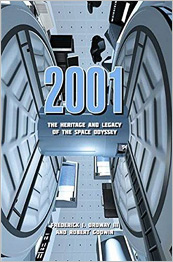 Apogee has one other 2001-related book worth mentioning. It’s a smaller paperback, less than half the size of the others, of about 140 pages. It was actually written by Frederick I. Ordway III (prior to his death) with Robert Godwin and published in 2015. It’s called 2001: The Heritage and Legacy of the Space Odyssey and is essentially Ordway’s personal history of his involvement with the film.
Apogee has one other 2001-related book worth mentioning. It’s a smaller paperback, less than half the size of the others, of about 140 pages. It was actually written by Frederick I. Ordway III (prior to his death) with Robert Godwin and published in 2015. It’s called 2001: The Heritage and Legacy of the Space Odyssey and is essentially Ordway’s personal history of his involvement with the film.
The book is broken into three parts, the first two of which are more traditional articles that were first published in 1982 by the American Astronautical Society, but were updated and expanded by Ordway for this book. The final part was written by Godwin, and looks at the overall history of science fiction film depictions of realistic manned spaceflight. All three portions are illustrated with black and white photos and artwork.
The book provides fine additional context to the two 2001: The Lost Science volumes, making it the perfect companion work.
 The next book worth mentioning is Reel Art Press’s The 2001 File: Harry Lange and the Design of the Landmark Science Fiction Film from 2015, written by the noted film historian Sir Christopher Frayling, whose previous film appreciation efforts have tended to focus on the Spaghetti Western genre (including the excellent 2000 book Sergio Leone: Something to Do with Death). As you’d expect from a company called Reel Art Press, The 2001 File is a much more physically refined coffee table tome, featuring embossed hard covers and very high quality paper and printing. It’s an ‘art’ book in every sense of the word. It also focuses on the other half of 2001’s design team… Harry Lange.
The next book worth mentioning is Reel Art Press’s The 2001 File: Harry Lange and the Design of the Landmark Science Fiction Film from 2015, written by the noted film historian Sir Christopher Frayling, whose previous film appreciation efforts have tended to focus on the Spaghetti Western genre (including the excellent 2000 book Sergio Leone: Something to Do with Death). As you’d expect from a company called Reel Art Press, The 2001 File is a much more physically refined coffee table tome, featuring embossed hard covers and very high quality paper and printing. It’s an ‘art’ book in every sense of the word. It also focuses on the other half of 2001’s design team… Harry Lange.
Well versed in the science of spaceflight and also an experienced designer, Lange had spent years working with Ordway and Werner Von Braun on spacecraft concepts at the Army Ballistic Missile Agency and later NASA. Following his experience on 2001, he remained in the film industry, working as an art director, set decorator, and/or production designer on such films as Moonraker, Superman II, The Dark Crystal, Monty Python’s The Meaning of Life, and all three original Star Wars films.
The 2001 File is a document of Lange’s personal archive of materials, created and used in the making of 2001: A Space Odyssey. At 336 pages and weighing a hefty 4.5 pounds, the book is filled with gorgeous color and B&W images of Lange’s sketches and designs, showing the development of the different concepts, equipment, vehicles, graphic imagery, and iconography seen in the film, often presented alongside photographs of the final designs. There’s also a running essay – in multiple parts – that details the history of Lange’s work on the film, his many ideas, and the ways the different concepts were created and developed. It features excerpts from the screenplay too, as well as production notes and other documents that illustrate the design process.
Moving on, the heavyweight entry in this selection of books must surely be Taschen’s The Making of Stanley Kubrick’s 2001: A Space Odyssey. Also published in 2015, it’s essentially a mass market version of a far more deluxe Limited Edition produced in 2014 (and that retailed for over $1200). The Limited Edition featured four volumes, including a book of still images, a book of interviews and behind-the-scenes material, a book of the screenplay, and a book of production notes. This mass market release is essentially just the behind-the-scenes volume from the larger set.
Weighing in at 5.6 pounds, and boasting 562 pages, this book researched and written by Piers Bizony, a noted spaceflight and technology journalist (who I’m proud to say is also a Facebook friend). The book is broken into sections, including Part I: A Journey Beyond the Stars, Part II: A King of Infinite Space, Part III: Santa’s Workshop, Part IV: The Dawn of Man, Part V: Stanley on Set, Part VI: They Loved It, They Hated It, Part VII: Yesterday’s Tomorrows, Part VIII: Are We Alone?, and Part IX: Film Synopsis. Each section features a Bizony essay illustrated with small thumbnail images, followed by an expansive gallery of those same images in much larger format, including many multi-page fold-out spreads.
The content itself is nothing short of superb, but the book’s weakness lies in its layout. An exquisitely designed hardback with cover embossing and a graphic slipcover, it has the unusual dimensions of 6.7” x 14.9” x 2.7”. Those are essentially the exact ratio as the dimensions of the iconic alien Monolith seen in the film. And that’s certainly cool. Unfortunately, at that size, it becomes very difficult to handle the book, and to appreciate all of its gorgeous photographs and artwork. It’s also awkward to open each fold-out and lay it flat enough to really appreciate the imagery. Still, that content is well worth the inconvenience.
So which of these books should you focus on if you’re a fan of 2001: A Space Odyssey? Well, it depends on your budget. For sheer content, detail, and quality of imagery, I would say that Apogee’s 2001: The Lost Science – The Frederick I. Ordway III Collection and 2001: The Lost Science – The Scientists, Influences & Designs should be your starting point. Each volume will run you about $50 (if they’re not available on Amazon, you can order them directly from Apogee’s website), but remember that each includes a DVD that you can add to your existing 2001: A Space Odyssey Blu-ray as a sort of makeshift “bonus disc”. Both books are absolutely must-have for fans.
In terms of sheer production value, Reel Art Press’ The 2001 File: Harry Lange and the Design of the Landmark Science Fiction Film is the best of these books. Again, it offers completely different – but complementary – artistic content than the Apogee volumes. It also sells for about $50 on Amazon (with an SRP of $75).
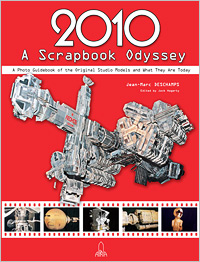 Taschen’s The Making of Stanley Kubrick’s 2001: A Space Odyssey is also excellent, in spite of its highly unusual format, and its essays are wonderfully revealing and insightful. But here’s the best part: The original SRP for this book was $69.99, but Amazon currently has it for just $26.51 at the moment – over 60% off.
Taschen’s The Making of Stanley Kubrick’s 2001: A Space Odyssey is also excellent, in spite of its highly unusual format, and its essays are wonderfully revealing and insightful. But here’s the best part: The original SRP for this book was $69.99, but Amazon currently has it for just $26.51 at the moment – over 60% off.
Apogee’s 2001: The Heritage and Legacy of the Space Odyssey is not a must-have, but remains a good companion to these other books, and sells for just $14 on Amazon at the moment.
For completists, and especially for model builders, there’s also at least one book available on the production and design work for film’s sequel, 2010, called 2010: A Scrapbook Odyssey. Published by ARA Press in 2010, this is an 88-page paperback “scrapbook” of sorts, featuring close-on photos of all of the model spacecraft seen in the film, including the Discovery, the Leonov, the Russian Pod, and the Starchild. It’s written by Jean-Marc Deschamps and runs about $24 used.
One thing is for sure: There’s never been a better time to be a fan of Stanley Kubrick’s 2001: A Space Odyssey. If you’re looking for behind-the-scenes artwork, stories, anecdotes, interviews, and other reference materials on the making of this science fiction classic, these fine books provide it in abundance. All are worth a look and are well recommended.
UPDATE (9/5/2023): MICHAEL BENSON’S SPACE ODYSSEY & MICHAEL COATE’S 2001 RETROSPECTIVE
Since the original publication of this column back in 2016, a new book on Stanley Kubrick’s 2001 has appeared that is so good and so full of insights on the production that it certainly deserves to be mentioned here—Michael Benson’s Space Odyssey.
 Unlike the other volumes covered above, this one isn’t a large-format art or coffee-table book. Instead, it’s a traditional non-fiction hardcover, published by Simon & Schuster in 2018. Essentially, Benson takes you from start to finish on the production almost day by day, chronicling the project’s origins, its development and elaborate pre-production, its multiple years of filming (from December 1965 to March 1968), the visual effects work that was underway the whole time… even the film’s release and aftermath.
Unlike the other volumes covered above, this one isn’t a large-format art or coffee-table book. Instead, it’s a traditional non-fiction hardcover, published by Simon & Schuster in 2018. Essentially, Benson takes you from start to finish on the production almost day by day, chronicling the project’s origins, its development and elaborate pre-production, its multiple years of filming (from December 1965 to March 1968), the visual effects work that was underway the whole time… even the film’s release and aftermath.
Space Odyssey is compiled from interviews with virtually every surviving member of the production, not to mention rare and unpublished interviews with nearly all of those participants who are no longer with us. Benson also conducted extensive research in Kubrick and author Arthur C. Clarke’s personal archives, and earned the support of Kubrick’s widow, Christiane. And the book features dozens of color and black and white photos from the production, many of them never-before published.
Having read this book cover to cover no less than twice, I can tell you from personal experience that it’s as definitive an account of the making of Kubrick’s 2001: A Space Odyssey as you will ever find. If you’ve already purchased the other books mentioned above, you will absolutely want to complete your exploration of what is arguably the greatest science fiction of all time by reading Benson’s work. It’s a marvel of research and storytelling.
Also, before we go, it’s well worth mentioning that our own Michael Coate published a terrific retrospective article here at The Digital Bits back in 2018—Still the Ultimate Trip: Remembering 2001: “A Space Odyssey” on its 50th Anniversary—that will definitely be of interest to fans of this film. Be sure to check it out for a comprehensive look back at the film’s original theatrical release, including detailed information about its 70 mm and roadshow engagements.
- Bill Hunt
(You can follow Bill on social media on Twitter and Facebook)


